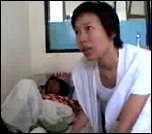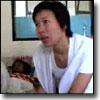MSF medical teams are working in Indonesia's Aceh province to assist people left homeless by the earthquake and tsunami disaster in South Asia. MSF volunteer nurse Elaine Lau describes her first days in Aceh with fellow MSF volunteer Albert Ko, an engineer.
Doctors Without Borders/Médecins Sans Frontières (MSF) medical teams are working in Indonesia's Aceh province to assist people left homeless by the earthquake and tsunami disaster in South Asia. MSF volunteer nurse Elaine Lau describes her first days in Aceh with fellow MSF volunteer Albert Ko, an engineer. The two experienced MSF volunteers have worked in previous emergencies in Afghanistan, Kosovo, Sudan, and Uzbekistan.
|

|
Banda Aceh, January 3, 2005
In the morning of January 1, I left Hong Kong for Jakarta, Indonesia, together with another MSF volunteer Albert Ko. We then boarded a cargo plane carrying medical supplies and some trucks to Aceh from Jakarta. We didn't arrive until 4 am the next morning.
Aceh is completely smashed, about 60 percent of the land has been completely shattered, one-third of the land was flooded, and there were dead bodies everywhere.
The situation in the hospital was bad. There are only two hospitals left in Aceh. There are not enough beds, and the injured have to lie on the floor to wait for treatment. Other relief workers told me that most of the buildings were destroyed, leaving people homeless. They have to stay in temples and schools until aid reaches them.
When I got to the hospital on January 2, I was immediately assigned to MSF's mobile medical supply center. I was helping organize medical supplies. It was already midnight when all the work was done. As resources are limited, including clean water, we were only given a little bucket of water for cleaning our thoroughly sweated body.
Albert's job was to find suitable locations to warehouse the medical supplies and materials that MSF airlifted into Aceh. He also worked with other team members to rebuild the water supplies facilities, in the hope of getting the water supply system up and running as soon as possible.
Today, I worked as part of one of the mobile medical teams operating in a remote area. Through door-to-door visits, we got a better picture of the medical services needed by the people. We were also able to locate more people and provide them with medical treatment.
Other relief teams are also working around the clock. Other than supporting the hospital and mobile medical center, the teams donated some corpse bags to the local organizations.
Meulaboh, January 10, 2005
Although I have taken part in several MSF aid missions, this is the first time I have worked in such a large-scale operation. I was psychologically ready for a tough mission, but nonetheless I did not realize how dire the situation was until I reached Aceh.
I worked with the MSF mobile clinic in Banda Aceh until January 6 when our base received an assessment report from an exploratory team. It revealed that Meulaboh, a town inaccessible since the earthquake and located on the west coast of Aceh, needed urgent assistance. The only hospital there was not functioning. With no medical care the health of large numbers of injured people was deteriorating rapidly.
Our coordinator immediately made the decision to send a medical team to Meulaboh to provide emergency care and to re-open the hospital. The team and I packed up at once, boarded the helicopter and set off for Meulaboh.
The helicopter ride took more than an hour. When we got to the hospital, we found the situation to be much worse than originally expected. Some areas were inundated with mud, while others were filled with dead bodies laid out on the ground. Many hospital staff died during the disaster. The survivors were busy searching for their remaining families. The building, once a hospital, was now empty.
Our team, including one Australian doctor, one Hong Kong nurse and six Indonesian medical workers started to rehabilitate the destroyed hospital. We cleaned mud off the wards, moved useable bed frames from debris, and looked for remaining equipment around the hospital to set up the wards. Meanwhile, we continued to provide treatment to patients.
In just three days, we renovated a surgical ward, a medical ward, and a pediatric ward, and set up a simple filing system of patients' medical records to maintain schedules for cleaning wounds and administering medications.




